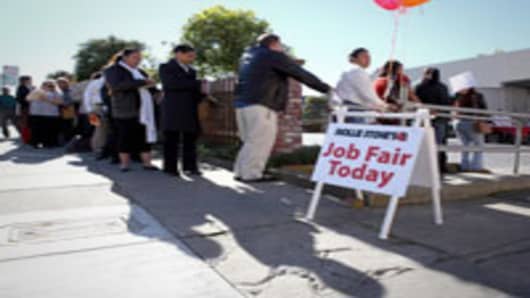Jobless claims and increasingly soggy-looking earnings news could set the tone for stocks Thursday, after a two-day rallyfueled by the prospect of more Fed easing.
Stocks rose Wednesday, as Fed Chairman Ben Bernanke testified before a Congressional committee for a second day.
Bernanke repeated his view that the economy has weakened, but he noted the Fed does not see a double dip recession.
He also said the Fed is committed to doing all it can to ensure progress in employment, and that it is ready to take action as needed.
The S&P was up 9, at 1372, just below 1375, its early July high and a point of key resistance. The Dow charged ahead by another 103 points, to 12,908, giving it a 1.4 percent gain over two days.
Bond yields, meanwhile, slid, taking the 10-year yield to 1.479 percent.
The Fed next meets at the end of the month, but many in the markets now expect it to take action at its September meeting.
Now that Bernanke has given his semi-annual testimony to Congress, traders may turn their attention to earnings and the state of the economy.
“I think this rally will fizzle out, and we’ll go back down,” said Andrew Burkly, senior market strategist with Brown Brothers Harriman. “We still think we’re going to the June lows of about 1300 in the next few weeks.”
Burkly said the recent pattern has been that stocks do best in the first part of the earnings period because the beaten up banks report first, and they have been surprising to the upside.
He said the recent rally has been unconvincing since it is a low volume rally, while the selloff in June was on higher volume.
“It’s a weak rally off the lows, and most of the economic data is mixed to poor, and I would say earnings are not that robust. They’re okay,” he said.
But he noted that the revenue growth is weaker, and so is some of the guidance.
Even with the majority beating on income, earnings news this week has been revealing a top line weakness in many S&P 500 companies.
For instance, IBM beat earningsestimates after Wednesday’s close by nine cents per share, but its revenues fell three percent to $25.8 billion, due to a $1 billion currency hit. IBM shares rose on a raised full-year earnings target.
American Express shares, meanwhile, fell after the company beat earnings estimates, but its revenues were slightly lower than expected, and its cardholder spending increased just 7 percent, slower than recent quarters.
F5 Networks fell sharply late Wednesday after weaker than expected profits on weaker revenues. It blamed a cautious spending environment world-wide for its disappointing fourth quarter outlook.
“To me, that’s really the tug of war. Economic reality on one hand and the prospect of more Fed action on the other,” said Peter Boockvar, market strategist with Miller Taback. “There’s a lot of cross currents. The 10-year at 1.48 is not saying “rah rah,” like stocks.”
here are a slew of earnings Thursday, including Morgan Stanley , Verizon , Travelers , Blackstone , Southwest Airlines , UnitedHealth and Quest Diagnostics before the opening bell.
Google , Microsoft , Chipotle Mexican Grill, Advanced Micro and Intuitive Surgical report after the close.
There are also weekly jobless claims, at 8:30 a.m. ET.
Existing home sales, the Philadelphia Fed survey, and leading indicators are reported at 10 a.m.
The Philadelphia Fed survey will also be scrutinized after it came in at a surprise negative 16.6 last month. It is expected to be positive two.
“Jobless claims are always important just as a snapshot. What it signals can help determine what the Fed does in two weeks. That will be based on what they think about the labor market and what they will get for data is just the data in claims,” Boockvar said.
Last week’s claims fell to 350,000, but the markets looked past that number, as it appeared seasonally impacted by the fact that auto companies did not shut down as much production as they usually do in the summer.
Economists expect to see 365,000 claims this week.
Boockvar expects the Fed to take some further easing action soon.
“I don’t’ think he (Bernanke) knows what to do and I’m sure they’ll discuss it at the next Fed meeting, and I have no doubt they’ll do QE at the end of July or September,” he said.
QE, or quantitative easing, could take the form of Fed purchases of Treasurys or mortgage securities.
“They’re certainly leaning in that direction because the U.S. economy is falling into recession, and the Fed will react to that by printing more money,”
Burkly said the easing could take another form, including using the discount window or direct lending.
“Arguably, it’s not going to be that effective given how low interest rates are already,” he said.
The market’s two big fears are Europe’s sovereign crisis, and the U.S. “fiscal cliff,” which is the expiration of tax cuts and automatic spending cuts that go into effect in the beginning of the year if Congress does not act.
“They’re both still out there. It’s not like anything changed at all on that level. Spanish yields were getting close to that 7 percent level again. The European situation has kind of quieted down right now because there’s no big summit or policy meeting,” Burkly said.
Burkly said he expects the market to stay in the range it’s been in this year, but it could move closer to the top of the range once there is clarity around the presidential election.
“The market is just push and pull between these different forces, but nothing that would show a big catalyst on the upside and nothing really dragging us down either,” he said.
Follow Patti Domm on Twitter: @pattidomm
Questions? Comments? Email us at marketinsider@cnbc.com



